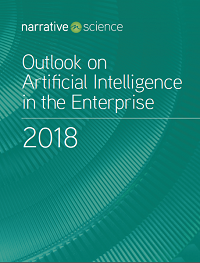 Narrative Science, a leader in Advanced Natural Language Generation (Advanced NLG) for the enterprise, announced the availability of its third annual research report, “Outlook on Artificial Intelligence in the Enterprise 2018.” In partnership with the National Business Research Institute (NBRI), Narrative Science surveyed business executives from a wide array of functions, including business intelligence, finance, and product management, to understand the use, value, and impact of AI throughout their businesses. Narrative Science’s analysis of the data revealed key findings, including the compelling discovery that almost two-thirds of enterprises utilized AI in 2017. The report explains in further detail:
Narrative Science, a leader in Advanced Natural Language Generation (Advanced NLG) for the enterprise, announced the availability of its third annual research report, “Outlook on Artificial Intelligence in the Enterprise 2018.” In partnership with the National Business Research Institute (NBRI), Narrative Science surveyed business executives from a wide array of functions, including business intelligence, finance, and product management, to understand the use, value, and impact of AI throughout their businesses. Narrative Science’s analysis of the data revealed key findings, including the compelling discovery that almost two-thirds of enterprises utilized AI in 2017. The report explains in further detail:
- AI adoption grew over 60% in the last year: In 2016, 38% of survey respondents said they had implemented AI within their businesses. In 2017, that number rose to 61%.
- Tech innovation is driving business strategy: 71% of respondents noted that their company has an ‘innovation strategy’ to drive investments in new technologies like AI.
- Artificial intelligence is to combine with business intelligence: 90% of respondents in the business intelligence function reported that they would be interested in incorporating AI to make their data and analytics tools smarter.
- Enterprises are experiencing ROI challenges: 31% of respondents are either not tracking ROI or are not seeing returns on their current AI investments.
This year’s survey illustrates that AI technology is being widely used today and its impact and application within the enterprise is growing,” said Stuart Frankel, CEO of Narrative Science. “Through comparison with our previous report, it is evident that AI implementation has significantly increased and the conversations around AI have turned from awareness to adoption. In 2018, the focus will be on ensuring enterprises get value from their AI investments.”
To download the full research report HERE.
Sign up for the free insideBIGDATA newsletter.




Speak Your Mind